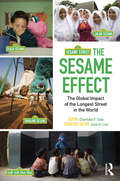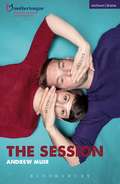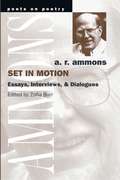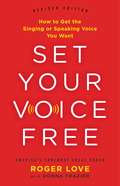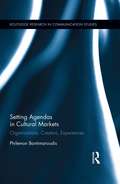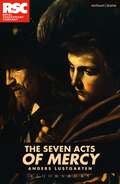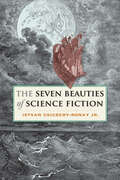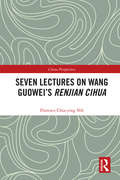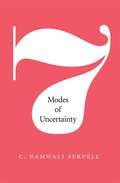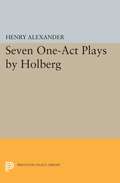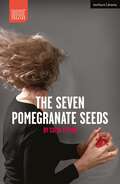- Table View
- List View
The Sesame Effect: The Global Impact of the Longest Street in the World
by Charlotte F. Cole June H. LeeThe Sesame Effect details the wide-ranging work of Sesame Workshop and its productions across the world. With an emphasis on impact and evidence from research on projects in low- and middle-income countries, the book tells the stories behind the development of an international family of Muppet characters created for the locally produced adaptations of Sesame Street. Each chapter highlights the educational message of international co-productions and presents the cultural context of each project. Readers will understand the specific needs of children living in a given locale, as well as gain insight into the educational drivers of each project. These projects often deal with difficult issues, from race relations in the United States, to HIV/AIDS education in South Africa, to building respect across cultural divides in the Middle East. Readers will see how local productions have helped build a new mindset that values the importance of early childhood education, and how Sesame Street promotes a brighter future by building children’s academic skills, encouraging healthy habits, and by fostering attitudes that counter negative stereotypes and create appreciation of and respect for others. The Sesame Effect shows how, when magnified across the millions of children touched by the various international programs, Sesame Workshop and its projects are making a difference around the world.
The Sesame Effect: The Global Impact of the Longest Street in the World
by Charlotte F. Cole June H. LeeThe Sesame Effect details the wide-ranging work of Sesame Workshop and its productions across the world. With an emphasis on impact and evidence from research on projects in low- and middle-income countries, the book tells the stories behind the development of an international family of Muppet characters created for the locally produced adaptations of Sesame Street. Each chapter highlights the educational message of international co-productions and presents the cultural context of each project. Readers will understand the specific needs of children living in a given locale, as well as gain insight into the educational drivers of each project. These projects often deal with difficult issues, from race relations in the United States, to HIV/AIDS education in South Africa, to building respect across cultural divides in the Middle East. Readers will see how local productions have helped build a new mindset that values the importance of early childhood education, and how Sesame Street promotes a brighter future by building children’s academic skills, encouraging healthy habits, and by fostering attitudes that counter negative stereotypes and create appreciation of and respect for others. The Sesame Effect shows how, when magnified across the millions of children touched by the various international programs, Sesame Workshop and its projects are making a difference around the world.
The Session (Modern Plays)
by Andrew MuirOne minute I'm in The Elk watching the footie the next minute I'm at the beach with a Polish supermodel. Fucking come on.Lena meets Robbie. Girl meets Boy. Head over heels. Eyes only for each other. They don't speak the same language, but they both know the language of love, and surely that's enough for a while – until the unspeakable happens and the truth comes spewing out. As their marriage hurtles towards oblivion, Lena and Robbie desperately attempt to find a common language and save their shared history.The Session is a heartfelt play about how couples communicate, taking in twenty years of a relationship that is based on misunderstanding and crossed wires. It received its world premiere at Soho Theatre on 3 November 2015.
The Session (Modern Plays)
by Andrew MuirOne minute I'm in The Elk watching the footie the next minute I'm at the beach with a Polish supermodel. Fucking come on.Lena meets Robbie. Girl meets Boy. Head over heels. Eyes only for each other. They don't speak the same language, but they both know the language of love, and surely that's enough for a while – until the unspeakable happens and the truth comes spewing out. As their marriage hurtles towards oblivion, Lena and Robbie desperately attempt to find a common language and save their shared history.The Session is a heartfelt play about how couples communicate, taking in twenty years of a relationship that is based on misunderstanding and crossed wires. It received its world premiere at Soho Theatre on 3 November 2015.
Set in Motion: Essays, Interviews, and Dialogues (Poets On Poetry)
by A. R. AmmonsSet in Motion collects for the first time the prose writings of A. R. Ammons, one of our most important and enduring contemporary poets. Hailed as a major force in American poetry by such redoubtable critics as Harold Bloom and Helen Vendler, Ammons has reflected upon the influences of luminaries like Emerson, Thoreau, Whitman, Frost, Stevens, and Williams while creating a compelling style and an artistic vision uniquely his own. Set in Motion includes essays, reviews, and interviews as well as a selection of Ammons's poems, with commentary from the author about their inspiration and effects. He takes up the questions that have been central to American poetry over the last forty years and connects them to the larger enterprise of living in a difficult, changing world. At a moment when the arts are under attack, Ammons reminds us of the crucial role poetry plays in teaching us to recognize and use sources of understanding that are irreducible to statement. A. R. Ammons is the author of Sphere, A Coast of Trees, and Garbage and was recently the editor of The Best American Poetry 1994. His awards include the MacArthur and Guggenheim fellowships, the Bollingen Prize, two National Book Awards, and prizes from the American Academy of Arts and Letters and the National Book Critics Circle. He is Goldwin Smith Professor of Poetry, Cornell University.
Set Lighting Technician's Handbook: Film Lighting Equipment, Practice, and Electrical Distribution
by Harry C. BoxA friendly, hands-on training manual and reference for lighting technicians in motion picture and television production, this handbook is the most comprehensive guide to set lighting available. It provides a unique combination of practical detail with a big-picture understanding of lighting, technology, safety, and professionalism, essential to anyone doing motion picture lighting. The fifth edition delves into every aspect of lighting and features vastly expanded sections on controlling LED lights, color science, lighting control systems, wireless systems, Ethernet-based control systems, battery power, and modern set protocol for productions small and large. With a generous number of original images, the book illustrates the use of soft light, the effect of lighting angles, and how the gaffer and DP build an effective lighting plan around the blocking of the actors. This encyclopedic volume of technical knowhow is tempered with years of practical experience and a much-needed sense of humor.This is the ideal text for professional lighting technicians across film and television including lighting directors, gaffers, DOPs, and rigging crews, as well as film and television production students studying lighting, camera techniques, film production, and cinematography.It includes a revamped companion website with supplementary resources, forms, checklists, and images.
Set Lighting Technician's Handbook: Film Lighting Equipment, Practice, and Electrical Distribution
by Harry C. BoxA friendly, hands-on training manual and reference for lighting technicians in motion picture and television production, this handbook is the most comprehensive guide to set lighting available. It provides a unique combination of practical detail with a big-picture understanding of lighting, technology, safety, and professionalism, essential to anyone doing motion picture lighting. The fifth edition delves into every aspect of lighting and features vastly expanded sections on controlling LED lights, color science, lighting control systems, wireless systems, Ethernet-based control systems, battery power, and modern set protocol for productions small and large. With a generous number of original images, the book illustrates the use of soft light, the effect of lighting angles, and how the gaffer and DP build an effective lighting plan around the blocking of the actors. This encyclopedic volume of technical knowhow is tempered with years of practical experience and a much-needed sense of humor.This is the ideal text for professional lighting technicians across film and television including lighting directors, gaffers, DOPs, and rigging crews, as well as film and television production students studying lighting, camera techniques, film production, and cinematography.It includes a revamped companion website with supplementary resources, forms, checklists, and images.
Set Your Voice Free: How to Get the Singing or Speaking Voice You Want
by Roger Love Donna FrazierEvery time we open our mouths, we have an effect on ourselves and the way others perceive us. The ability to speak clearly and confidently can make or break a presentation, an important meeting, or even a first date. Now, with the advent of Skype, YouTube, podcasting, Vine, and any number of reality talent competitions, your vocal presence has never been more necessary for success or more central to achieving your dreams. Roger Love has over 30 years of experience as one of the world's leading authorities on voice. Making use of the innovative techniques that have worked wonders with his professional clients, Love distills the best of his teaching in Set Your Voice Free, and shares exercises that will help readers bring emotion, range, and power to the way they speak. This updated edition incorporates what he's learned in the last 15 years as the Internet and talent competitions have completely changed the role your voice plays in your life. These are the new essentials for sounding authentic, persuasive, distinctive, and real in a world that demands nothing less.
Setting Agendas in Cultural Markets: Organizations, Creators, Experiences (Routledge Research in Communication Studies)
by Philemon BantimaroudisThis book draws on agenda setting theory to examine how cultural organizations relate to media in order to increase their visibility, valence, and eventually build their public image. Most organizations have a keen interest in their symbolic presence, as their media visibility influences public knowledge, perceptions and even behaviors. Diminished public funding, in combination with the global proliferation of cultural entities, creates a competitive environment, leading to a transformation of cultural industries. In the book, several questions are under scrutiny: How do cultural organizations acquire symbolic significance? How do they become prominent in media content? Which mechanisms and processes should be examined by cultural managers as they set out to achieve salience? Is there a relationship between media and public salience? In other words, if an organization becomes symbolically prominent, in what ways is the public influenced, both in terms of perceptions as well as behaviors?
Setting Agendas in Cultural Markets: Organizations, Creators, Experiences (Routledge Research in Communication Studies)
by Philemon BantimaroudisThis book draws on agenda setting theory to examine how cultural organizations relate to media in order to increase their visibility, valence, and eventually build their public image. Most organizations have a keen interest in their symbolic presence, as their media visibility influences public knowledge, perceptions and even behaviors. Diminished public funding, in combination with the global proliferation of cultural entities, creates a competitive environment, leading to a transformation of cultural industries. In the book, several questions are under scrutiny: How do cultural organizations acquire symbolic significance? How do they become prominent in media content? Which mechanisms and processes should be examined by cultural managers as they set out to achieve salience? Is there a relationship between media and public salience? In other words, if an organization becomes symbolically prominent, in what ways is the public influenced, both in terms of perceptions as well as behaviors?
Setting Plato Straight: Translating Ancient Sexuality in the Renaissance
by Todd W. ReeserWhen we talk of platonic love or relationships today, we mean something very different from what Plato meant. For this, we have fifteenth and sixteenth-century European humanists to thank. As these scholars—most of them Catholic—read, digested, and translated Plato, they found themselves faced with a fundamental problem: how to be faithful to the text yet not propagate pederasty or homosexuality. In Setting Plato Straight, Todd W. Reeser undertakes the first sustained and comprehensive study of Renaissance textual responses to Platonic same-sex sexuality. Reeser mines an expansive collection of translations, commentaries, and literary sources to study how Renaissance translators transformed ancient eros into non-erotic, non-homosexual relations. He analyzes the interpretive lenses translators employed and the ways in which they read and reread Plato’s texts. In spite of this cleansing, Reeser finds surviving traces of Platonic same-sex sexuality that imply a complicated, recurring process of course-correction—of setting Plato straight.
Setting Plato Straight: Translating Ancient Sexuality in the Renaissance
by Todd W. ReeserWhen we talk of platonic love or relationships today, we mean something very different from what Plato meant. For this, we have fifteenth and sixteenth-century European humanists to thank. As these scholars—most of them Catholic—read, digested, and translated Plato, they found themselves faced with a fundamental problem: how to be faithful to the text yet not propagate pederasty or homosexuality. In Setting Plato Straight, Todd W. Reeser undertakes the first sustained and comprehensive study of Renaissance textual responses to Platonic same-sex sexuality. Reeser mines an expansive collection of translations, commentaries, and literary sources to study how Renaissance translators transformed ancient eros into non-erotic, non-homosexual relations. He analyzes the interpretive lenses translators employed and the ways in which they read and reread Plato’s texts. In spite of this cleansing, Reeser finds surviving traces of Platonic same-sex sexuality that imply a complicated, recurring process of course-correction—of setting Plato straight.
Setting Plato Straight: Translating Ancient Sexuality in the Renaissance
by Todd W. ReeserWhen we talk of platonic love or relationships today, we mean something very different from what Plato meant. For this, we have fifteenth and sixteenth-century European humanists to thank. As these scholars—most of them Catholic—read, digested, and translated Plato, they found themselves faced with a fundamental problem: how to be faithful to the text yet not propagate pederasty or homosexuality. In Setting Plato Straight, Todd W. Reeser undertakes the first sustained and comprehensive study of Renaissance textual responses to Platonic same-sex sexuality. Reeser mines an expansive collection of translations, commentaries, and literary sources to study how Renaissance translators transformed ancient eros into non-erotic, non-homosexual relations. He analyzes the interpretive lenses translators employed and the ways in which they read and reread Plato’s texts. In spite of this cleansing, Reeser finds surviving traces of Platonic same-sex sexuality that imply a complicated, recurring process of course-correction—of setting Plato straight.
Setting Plato Straight: Translating Ancient Sexuality in the Renaissance
by Todd W. ReeserWhen we talk of platonic love or relationships today, we mean something very different from what Plato meant. For this, we have fifteenth and sixteenth-century European humanists to thank. As these scholars—most of them Catholic—read, digested, and translated Plato, they found themselves faced with a fundamental problem: how to be faithful to the text yet not propagate pederasty or homosexuality. In Setting Plato Straight, Todd W. Reeser undertakes the first sustained and comprehensive study of Renaissance textual responses to Platonic same-sex sexuality. Reeser mines an expansive collection of translations, commentaries, and literary sources to study how Renaissance translators transformed ancient eros into non-erotic, non-homosexual relations. He analyzes the interpretive lenses translators employed and the ways in which they read and reread Plato’s texts. In spite of this cleansing, Reeser finds surviving traces of Platonic same-sex sexuality that imply a complicated, recurring process of course-correction—of setting Plato straight.
Settler and Creole Reenactment (Re-Enactment History)
by V. Agnew J. LambExplores the uncalculated and incalculable elements in historical re-enactment - unexpected emotions, unplanned developments - and locates them in countries where settlers were trying to establish national identities derived from metropolitan cultures inevitably affected by the land itself and the people who had been there before them.
The Seven Acts of Mercy (Modern Plays)
by Anders LustgartenYou have to be tough to be kind. That's what I've learned from you, Granddad. Tough and fearless and strong. So that's what I'm going to be.Naples, 1606. Inside an unfinished church, a painting is emerging from the darkness. The Seven Acts of Mercy is Caravaggio's masterpiece - and his first painting since he killed a man and fled Rome. As the artist works, he is fueled by anger, self-loathing and his driving need to create a work that speaks of compassion in a violent world. Bootle, the present day. A retired dock worker teaches his grandson, as around them a community is disintegrating under the pressure of years of economic and political degradation. With all he has left, a book of great works of art, he tries to open the boy's eyes to the tragedy and beauty of the life he faces. And the boy reciprocates in the only way he knows.Playing out across a gap of 400 years, Anders Lustgarten's visceral play confronts the dangerous necessity of compassion, in a world where it is in short supply. The Seven Acts of Mercy received its world premiere at the Swan Theatre, RSC, on 24 November 2016.
The Seven Acts of Mercy (Modern Plays)
by Anders LustgartenYou have to be tough to be kind. That's what I've learned from you, Granddad. Tough and fearless and strong. So that's what I'm going to be.Naples, 1606. Inside an unfinished church, a painting is emerging from the darkness. The Seven Acts of Mercy is Caravaggio's masterpiece - and his first painting since he killed a man and fled Rome. As the artist works, he is fueled by anger, self-loathing and his driving need to create a work that speaks of compassion in a violent world. Bootle, the present day. A retired dock worker teaches his grandson, as around them a community is disintegrating under the pressure of years of economic and political degradation. With all he has left, a book of great works of art, he tries to open the boy's eyes to the tragedy and beauty of the life he faces. And the boy reciprocates in the only way he knows.Playing out across a gap of 400 years, Anders Lustgarten's visceral play confronts the dangerous necessity of compassion, in a world where it is in short supply. The Seven Acts of Mercy received its world premiere at the Swan Theatre, RSC, on 24 November 2016.
The Seven Basic Plots: Why We Tell Stories
by Christopher BookerThis remarkable and monumental book at last provides a comprehensive answer to the age-old riddle of whether there are only a small number of 'basic stories' in the world. Using a wealth of examples, from ancient myths and folk tales via the plays and novels of great literature to the popular movies and TV soap operas of today, it shows that there are seven archetypal themes which recur throughout every kind of storytelling. But this is only the prelude to an investigation into how and why we are 'programmed' to imagine stories in these ways, and how they relate to the inmost patterns of human psychology. Drawing on a vast array of examples, from Proust to detective stories, from the Marquis de Sade to E.T., Christopher Booker then leads us through the extraordinary changes in the nature of storytelling over the past 200 years, and why so many stories have 'lost the plot' by losing touch with their underlying archetypal purpose.Booker analyses why evolution has given us the need to tell stories and illustrates how storytelling has provided a uniquely revealing mirror to mankind's psychological development over the past 5000 years.This seminal book opens up in an entirely new way our understanding of the real purpose storytelling plays in our lives, and will be a talking point for years to come.
The Seven Beauties of Science Fiction
by Istvan Csicsery-RonayAs the world undergoes daily transformations through the application of technoscience to every aspect of life, science fiction has become an essential mode of imagining the horizons of possibility. However much science fiction texts vary in artistic quality and intellectual sophistication, they share in a mass social energy and a desire to imagine a collective future for the human species and the world. At this moment, a strikingly high proportion of films, commercial art, popular music, video and computer games, and non-genre fiction have become what Csicsery-Ronay calls science fictional, stimulating science-fictional habits of mind. We no longer treat science fiction as merely a genre-engine producing formulaic effects, but as a mode of awareness, which frames experiences as if they were aspects of science fiction. The Seven Beauties of Science Fiction describes science fiction as a constellation of seven diverse cognitive attractions that are particularly formative of science-fictionality. These are the "seven beauties" of the title: fictive neology, fictive novums, future history, imaginary science, the science-fictional sublime, the science-fictional grotesque, and the Technologiade, or the epic of technsocience's development into a global regime.
Seven Lectures on Wang Guowei’s Renjian Cihua (China Perspectives)
by Florence Chia-Ying YehRenjian cihua is a masterpiece of literary criticism written by Wang Guowei (1877–1927), a scholar of the Chinese classics who lived during the late Qing and early Republican periods. Since its publication in 1908 and 1909, it has been one of the most influential academic works in China. Elegantly written, Wang’s set of "remarks on ci poetry" (cihua) retains a traditional Chinese impressionistic critical approach, and can present difficulties to the common reader. This set of lectures by Florence Chia-ying Yeh explains the text to readers, making accessible Wang’s famous theory of jingjie ("aesthetic realm" or "artistic conception"), his views on how the ci differs from the shi genre of Chinese poetry, and his critical judgments of various famous ci poets from the Tang, Five Dynasties, and Song periods. The lectures are presented here in an English translation by Maija Bell Samei.
Seven Lectures on Wang Guowei’s Renjian Cihua (China Perspectives)
by Florence Chia-Ying YehRenjian cihua is a masterpiece of literary criticism written by Wang Guowei (1877–1927), a scholar of the Chinese classics who lived during the late Qing and early Republican periods. Since its publication in 1908 and 1909, it has been one of the most influential academic works in China. Elegantly written, Wang’s set of "remarks on ci poetry" (cihua) retains a traditional Chinese impressionistic critical approach, and can present difficulties to the common reader. This set of lectures by Florence Chia-ying Yeh explains the text to readers, making accessible Wang’s famous theory of jingjie ("aesthetic realm" or "artistic conception"), his views on how the ci differs from the shi genre of Chinese poetry, and his critical judgments of various famous ci poets from the Tang, Five Dynasties, and Song periods. The lectures are presented here in an English translation by Maija Bell Samei.
Seven Modes of Uncertainty
by C. Namwali SerpellLiterature is uncertain. Literature is good for us. These two ideas are often taken for granted. But what is the relationship between literature's capacity to perplex and its ethical value? Seven Modes of Uncertainty contends that literary uncertainty is crucial to ethics because it pushes us beyond the limits of our experience.
Seven Modes of Uncertainty
by C. Namwali SerpellLiterature is uncertain. Literature is good for us. These two ideas are often taken for granted. But what is the relationship between literature's capacity to perplex and its ethical value? Seven Modes of Uncertainty contends that literary uncertainty is crucial to ethics because it pushes us beyond the limits of our experience.
Seven One-Act Plays by Holberg
by Ludvig Holberg Henry AlexanderThese short plays by the great Danish-Norwegian playwright Ludvig Holberg reveal, in brilliant and sparking miniature, his genius for comedy. The plays are here translated into English for the first time, with an introduction by Svend Kragh-Jacobsen, well-known Danish theater critic. In these social comedies Holberg pricks the vanity of snobbery and the worship of riches, deals with the world of the philosophers, and has fun with the theme of common sense. A talkative barber, a scientific charlatan, and an ignorant farmer boy come in for sharp characterization.Originally published in 1950.The Princeton Legacy Library uses the latest print-on-demand technology to again make available previously out-of-print books from the distinguished backlist of Princeton University Press. These editions preserve the original texts of these important books while presenting them in durable paperback and hardcover editions. The goal of the Princeton Legacy Library is to vastly increase access to the rich scholarly heritage found in the thousands of books published by Princeton University Press since its founding in 1905.
The Seven Pomegranate Seeds (Modern Plays)
by Colin TeevanSeven contemporary stories grounded in prominent, mythical origins.Persephone, Hypsipyle, Medea, Alcestis, Phaedra, Creusa and Demeter: the women of Euripides' plays are reimagined as people of today in an unexpected fusion of celebrity, inappropriate desires, historical police investigations and missing children.A severed maternal bond threads each story together, charting a journey through rage and redemption, towards a compelling conclusion.This revised edition of Colin Teevan's haunting monologue cycle was published to coincide with a new production at Rose Theatre, Kingston, in November 2021.
